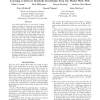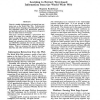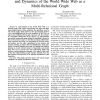300 search results - page 1 / 60 » Extracting Patterns and Relations from the World Wide Web |
WEBDB
1998
Springer
13 years 9 months ago
1998
Springer
The World Wide Web is a vast resource for information. At the same time it is extremely distributed. A particular type of data such as restaurant lists maybe scattered across thous...
AAAI
1998
13 years 6 months ago
1998
The World Wide Web is a vast source of information accessible to computers, but understandable only to humans. The goal of the research described here is to automatically create a...
WWW
2005
ACM
14 years 5 months ago
2005
ACM
We describe Thresher, a system that lets non-technical users teach their browsers how to extract semantic web content from HTML documents on the World Wide Web. Users specify exam...
KDD
1997
ACM
13 years 9 months ago
1997
ACM
Thereis a wealthof informationto be minedfromnarrative text on the WorldWideWeb.Unfortunately, standard natural language processing (NLP)extraction techniques expect full, grammat...
SOCIALCOM
2010
13 years 2 months ago
2010
A representation of the World Wide Web as a directed graph, with vertices representing web pages and edges representing hypertext links, underpins the algorithms used by web search...



